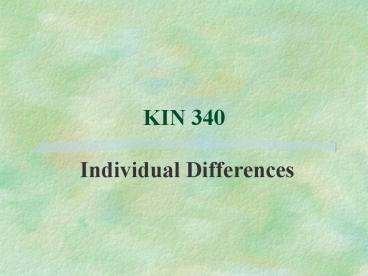KIN 340 - PowerPoint PPT Presentation
1 / 21
Title:
KIN 340
Description:
... possess all of the abilities ... singular global ability is the bases for all ... ways to work on weaknesses (e.g., tennis ability, but weak serve) ... – PowerPoint PPT presentation
Number of Views:58
Avg rating:3.0/5.0
Title: KIN 340
1
KIN 340
- Individual Differences
2
What is the difference between Experimental
Psychology and Differential Psychology?
- Experimental
- is concerned with group means (look at average
behavior) - Differential Psychology
- is concerned with individual differences
3
Why would we as physical educators and exercise
scientists be interested in differential
psychology?
- Not all are created equal
- Who is average?
- Maximum success
- Individuals learn differently
- Individuals communicate differently
- Different levels of ability
4
Definitions
- Ability
- A general trait or capacity of an individual
which is related or or underlies performance on a
variety of human tasks. - Motor Skill
- A highly specific motor response that is
developed to produce a specific result
5
Definitions
- Motor Capacity
- A person's inborn, hereditary potential for
general motor performance - Motor Educability
- The ease with which an individual learns new
motor skills
6
Why study Abilities?
- Predict one ability from another
- Predict success
- Group individuals for teaching instructions and
strategies - Recruiting athletes
- Curriculum directions and development
7
Number of Cognitive and Motor Abilities
- 20-30 identified
- Assume all individuals possess all of the
abilities - What is different between individuals, however?
- The strength of the ability
8
Three Views of Abilities
- General Motor Ability (GMA)
- singular global ability is the bases for all
skill performance - you are either born with it, or not
- idea that individuals who possess high levels of
general motor ability should always produce high
levels of performance (or if low ability low
performance)
9
Three Views of Abilities
- Henry's Specificity Hypothesis (1958)
- movement behaviors and performance on any task
are based on a large number of specific abilities - these abilities are independent of each other
- these abilities are either weak or strong
10
Three Views of Abilities
- Fleishman's Motor Abilities Hypothesis
- abilities are independent of each other (like
Henry) - separate tasks may require some of the same
underlying abilities - groups abilities into two larger categories
- perceptual motor abilities (multi-limb
coordination, reaction time, aiming, finger
dexterity) - physical proficiency abilities (strength,
flexibility, balance and visual cues, speed,
stamina)
11
Activity
- On page 34 complete the It Depends
- Share your answers with a partner
- As a pair decide on best answers
12
How do you explain the notion of an "All-Around
Athlete" or "Natural" Athlete?
- Individual possesses strength in several
abilities - Tasks require the same subset of underlying
abilities - Any others?
13
How Does an Individual Become a Skilled Performer?
- Must have the ability
- Have the potential
- Spend many hours practicing the task
14
Implications forTeaching and Coaching
- Abilities tend to be specific-facilitates
performance on some tasks more than others - Prediction from ability tests is very difficult
- Do not judge your talent too quickly
- Specificity of training
15
Implications forTeaching and Coaching (cont.)
- Individuals cannot be grouped into ability
classifications based on general motor ability or
educability tests. Use sport specific tests. - Find creative ways to work on weaknesses (e.g.,
tennis ability, but weak serve) - Performance is due to other factors-experience,
body configuration, personal characteristics - Success is due to a combination of factors
16
Activity
- With a partner answer the question in the it
depends. - Share your response with the class
17
Group Project
- End Here
18
Goals and Problems
- Define the goals.
- Define the problems.
- Encourage participants to focus on the issues
and assign priorities.
TIP Support the opinions andexperiences of
others withpositive comments andpositive
attitude.
19
Solutions and Opportunities
- Invite comments and ideas from the audience.
- Record and display their comments regarding
action plans and solutions. - Invite participants toprioritize options.
TIP Recognize that diversity ina group is
positive, addingstrength and substance.
20
Action Plan
- Describe the following (where additional
information is needed assign responsibility to
the logical person) - Action steps.
- Materials needed.
- Training needed.
- Schedules.
- Costs.
21
Close
- Insure understanding.
- Describe first steps.
- Get commitment.
TIP Close your presentation tomake a
favorable, lastingimpression































